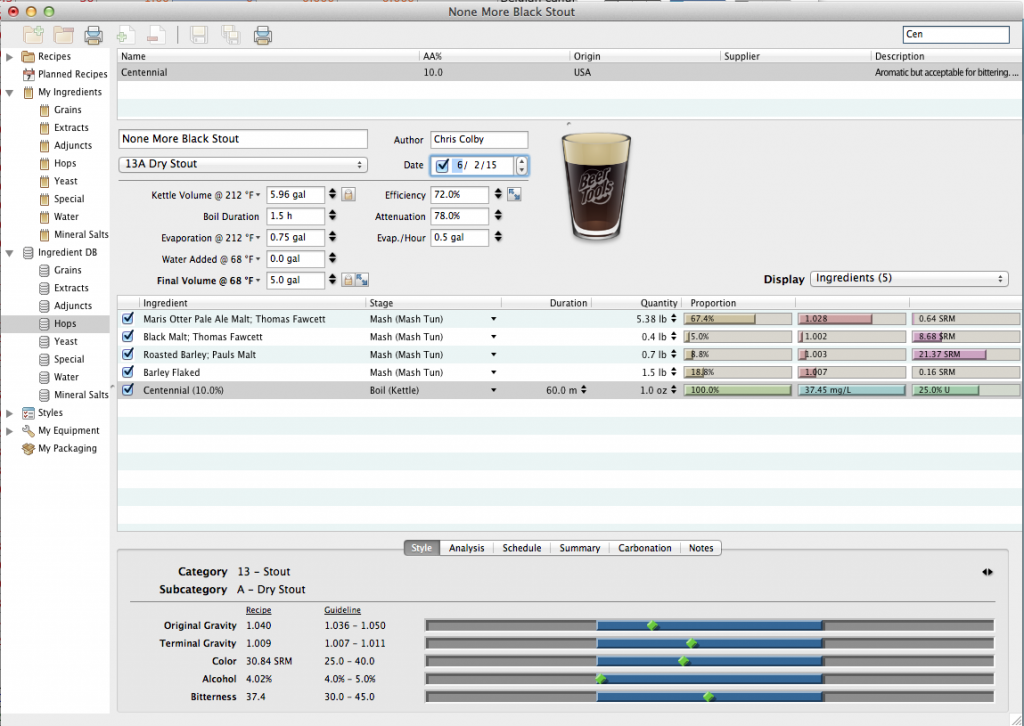 I like a wide variety of beers, but one style of beer I always come back to is dry stout. Dry stout is a great session beer. It can also be a great “sobering up” beer. If you’re at the end of a long night of beer drinking, but still want one more beer, sipping a dry stout can be a great closer. It’s lower in alcohol than most beers, so you can enjoy it and also slow down a bit. It’s also a great “I could stand to lose a few pounds” beer, as the Calorie count is lower than most beers. But mostly, it’s a dark, roasty, delicious beer that is always flavorful and smells wonderful.
I like a wide variety of beers, but one style of beer I always come back to is dry stout. Dry stout is a great session beer. It can also be a great “sobering up” beer. If you’re at the end of a long night of beer drinking, but still want one more beer, sipping a dry stout can be a great closer. It’s lower in alcohol than most beers, so you can enjoy it and also slow down a bit. It’s also a great “I could stand to lose a few pounds” beer, as the Calorie count is lower than most beers. But mostly, it’s a dark, roasty, delicious beer that is always flavorful and smells wonderful.
Most of the time I brew a dry stout, I go with my Cure from Cork recipe — a stout inspired by Murphy’s Stout. However, there is a fairly wide range of flavors within dry stouts and sometimes I like to brew a version that’s closer to Guinness Draught. The homebrewing world is awash with Guinness clones, so I’m not about to throw another on the pile. This is a dry stout that is its own beer, but is nevertheless closer to Guinness Draft than it is to either Murphy’s or Beamish. (And of course, there’s no reason a dry stout needs to imitate any of these three.) So this is my “other” dry stout recipe.
Brewing the stout is straightforward. I use a single infusion mash. Although I mill the dark grains separately, I mash all the grains together. (Some brewers add the dark grains to the top part of the mash after the base malt has been mashing a awhile.) The only thing that might seem odd to some brewers is that I collect less than the full pre-boil volume, and add water to reach my target. This is so I don’t oversparge the grain bed. Other than that, it’s an easy brewday and the beer ferments and conditions quickly. Given the low ABV and relatively small grain bill, I sometimes make a 10-gallon (38-L) batch by doubling all the ingredients. This requires a 15-gallon (57-L) kettle for the boil, but a 10-gallon (38-L) mash tun is more than large enough to hold a double load of grain.
None More Black Stout
Dry stout
by Chris Colby
All-grain; English units
DESCRIPTION
This is a dry stout reminiscent of Guinness. This beer features some black malt along with the usual roasted barley found in a dry stout. This isn’t traditional, but gives the beer a roasted character I like. I use American hops (Centennial) and an American ale yeast, but the beer is dominated by the flavors and aromas of the roasted grains and doesn’t taste markedly dissimilar from a dry stout brewed with English hops and Irish or English ale yeast. Essentially, if you like dry stout in general and Guinness in particular, you will like this beer although you will not confuse it with Guinness.
INGREDIENTS (for 5 gallons)
Water
80 ppm calcium (Ca+2)
20 ppm magnesium (Mg+2)
240 ppm carbonate (HCO3–)
Malts and Other Fermentables (for an OG of 1.040 at 70% extract efficiency and an SRM of 51)
5 lb. 6 oz. English pale ale malt
1 lb. 8 oz. flaked barley
11 oz. roasted barley (500 °L)
6.5 oz. black malt
Hops (for 37 IBU total)
Centennial hops (37 IBUs)
1.0 oz. (at 10% alpha acids), boiled for 60 minutes
Yeast (to attenuate to FG 1.009, for an ABV of 4.1%)
Wyeast 1056 (American Ale) or White Labs WLP001 (California Ale) yeast
(a 1-qt. yeast starter is suggested)
Other
4.25 oz. corn sugar (to prime bottles for 2.3 volumes of CO2)
PROCEDURE
Make yeast starter 2 days ahead of time. If milling your own grains, crush the dark grains separately from the pale malt. (You will likely need to tighten the mill gap a bit for the smaller dark grains.) Mix the grains together and mash them in 11 qts. of water. Use a single infusion mash with a rest temperature of 150 °F. Rest for 60 minutes. If feasible, mash out to 168 °F before recirculation. Collect around 5.0 gallons of wort, then add sufficient water to reach a reasonable pre-boil volume for a 90-minute boil. (This should be around 6.5–7.0 gallons on most homebrew systems.) Don’t oversparge and collect the full pre-boil wort from the grain bed. Boil the wort for 90 minutes, adding hops at the 60-minute left mark. Chill wort and transfer to fermenter. Aerate and pitch yeast. Ferment at 68 °F.
None More Black Stout
Dry stout
by Chris Colby
All-grain; metric units
INGREDIENTS (for 19 L)
Water
80 ppm calcium (Ca+2)
20 ppm magnesium (Mg+2)
240 ppm carbonate (HCO3–)
Malts and Other Fermentables (for an OG of 1.040 at 70% extract efficiency and an SRM of 51)
2.4 kg English pale ale malt
680 g flaked barley
320 g roasted barley (500 °L)
180 g black malt
Hops (for 37 IBU total)
Centennial hops (37 IBUs)
28 g (at 10% alpha acids), boiled for 60 minutes
Yeast (to attenuate to FG 1.009, for an ABV of 4.1%)
Wyeast 1056 (American Ale) or White Labs WLP001 (California Ale) yeast
(a 1-L yeast starter is suggested)
Other
120 g corn sugar (to prime bottles for 2.3 volumes of CO2)
PROCEDURE
Make yeast starter 2 days ahead of time. If milling your own grains, crush the dark grains separately from the pale malt. (You will likely need to tighten the mill gap a bit for the smaller dark grains.) Mix the grains together and mash them in 10 L of water. Use a single infusion mash with a rest temperature of 66 °C. Rest for 60 minutes. If feasible, mash out to 76 °C before recirculation. Collect around 19 L of wort, then add sufficient water to reach a reasonable pre-boil volume for a 90-minute boil. (This should be around 25–27 L on most homebrew systems.) Don’t oversparge and collect the full pre-boil wort from the grain bed. Boil the wort for 90 minutes, adding hops at the 60-minute left mark. Chill wort and transfer to fermenter. Aerate and pitch yeast. Ferment at 20 °C.
—
Related Articles


Speak Your Mind